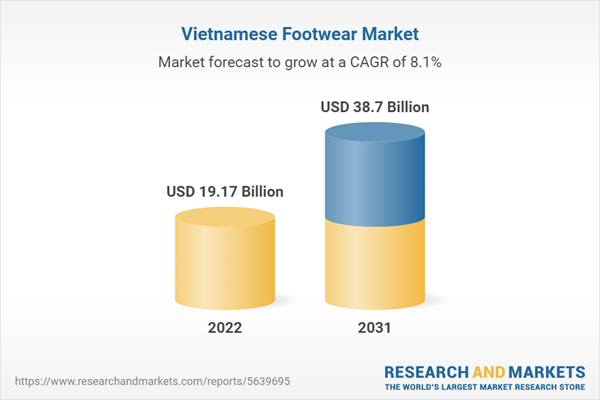Footwear Market in Vietnam
As one of the world’s leading footwear manufacturers, Vietnam ranks second in the world in terms of leather and footwear exports after China. Vietnam exports more than 1 billion pairs of footwear of all kinds of to hundreds of countries around the world every year. In particular, Vietnam’s footwear exports to the EU account for the largest proportion of the total exports. By the end of 2021, there are about 2,200 enterprises producing footwear in Vietnam, mainly concentrated in the area around Ho Chi Minh City.According to the analyst's analysis, two giant brands in the global footwear industry, Nike and Adidas, have chosen Vietnam as their main production base. Part of the global footwear chain is gradually shifting from China to Vietnam due to its lower costs. Nike has more than 100 suppliers in Vietnam, with 96 factories concentrated in the southern region.
Nike’s arch rival, Adidas, has also chosen Vietnam as its main production area. In its annual report (2020), Adidas suggested that in 2019, 98% of Adidas’ footwear products were produced in the Asian region. Vietnam has become the largest sourcing country for Adidas, accounting for about 40% of its total footwear production in 2021.
According to the analyst's analysis, due to the impact of COVID-19, Vietnam’s footwear exports was USD16.75 billion in 2020, decreased 8.6% YOY. In 2021, Vietnam’s footwear products were exported to more than 100 countries, with about 17.8 billion USD in footwear production. In 2021, Vietnam’s footwear exports have seen a resurgence in growth.
There is a more important basis for the bullishness of Vietnam’s footwear exports, that is, Vietnam has signed trade agreements helpful for exports with Europe and the United States. For example, in the EU-Vietnam Free Trade Agreement (EVFTA), Vietnam’s footwear exports to the EU amount to about 40%. The Comprehensive and Progressive Agreement for Trans-Pacific Partnership (CPTPP) has helped Vietnam’s footwear exports to Canada and Mexico soar.
Vietnam has signed many agreements with developed countries that are conducive to promoting exports, but the strength of Vietnam’s local footwear enterprises remains weak and the major market share of Vietnam’s footwear industry is occupied by foreign companies. According to the analysis, Vietnam’s footwear production and exports are expected to continue to grow in 2022-2031. For companies related to the international footwear industry chain, there are many investment opportunities in Vietnam’s market in the coming years.
Topics covered:
- Overview of Vietnam’s Footwear Industry
- Economic and Policy Environment of Vietnam’s Footwear Industry
- What is the impact of COVID-19 on the footwear manufacturing industry in Vietnam?
- Vietnam Footwear Market Size, 2016-2021
- Forecast on Vietnam’s Footwear Market, 2022-2031
- Analysis of Major Footwear Manufacturing Companies in Vietnam
- Key Drivers and Market Opportunities in Vietnam Footwear Industry
- What are the key drivers, challenges and opportunities for the footwear industry in Vietnam during 2022-2031?
- What is the expected revenue of Vietnam’s footwear market during 2022-2031?
- What are the strategies adopted by the key players in the market to increase their market share in the industry?
- Which segment of Vietnam’s footwear market is expected to dominate the market in 2031?
- What are the major adverse factors facing the footwear industry in Vietnam?
Table of Contents
Companies Mentioned
- Nike
- Adidas
- BINH TIEN IMEX CORP., PTE., LTD.
- Vinagiay Corporation
- Development History of VINAGIAY CORPORATION
- Main Products of VINAGIAY CORPORATION
- Operating model of VINAGIAY CORPORATION
- AN BA LEATHER FOOTWEAR ONE MEMBER CO., LTD
- Saigeon Footwear Joint Stock Company
- Vinh Long Footwear Co.
- Sahara International Corporation
- Golden Star Company Limited
- Mai Nguyen Fashions Joint Stock Company
Methodology
Background research defines the range of products and industries, which proposes the key points of the research. Proper classification will help clients understand the industry and products in the report.
Secondhand material research is a necessary way to push the project into fast progress. The analyst always chooses the data source carefully. Most secondhand data they quote is sourced from an authority in a specific industry or public data source from governments, industrial associations, etc. For some new or niche fields, they also "double-check" data sources and logics before they show them to clients.
Primary research is the key to solve questions, which largely influence the research outputs. The analyst may use methods like mathematics, logical reasoning, scenario thinking, to confirm key data and make the data credible.
The data model is an important analysis method. Calculating through data models with different factors weights can guarantee the outputs objective.
The analyst optimizes the following methods and steps in executing research projects and also forms many special information gathering and processing methods.
1. Analyze the life cycle of the industry to understand the development phase and space.
2. Grasp the key indexes evaluating the market to position clients in the market and formulate development plans
3. Economic, political, social and cultural factors
4. Competitors like a mirror that reflects the overall market and also market differences.
5. Inside and outside the industry, upstream and downstream of the industry chain, show inner competitions
6. Proper estimation of the future is good guidance for strategic planning.

LOADING...
Table Information
| Report Attribute | Details |
|---|---|
| No. of Pages | 60 |
| Published | July 2022 |
| Forecast Period | 2022 - 2031 |
| Estimated Market Value ( USD | $ 19.17 Billion |
| Forecasted Market Value ( USD | $ 38.7 Billion |
| Compound Annual Growth Rate | 8.1% |
| Regions Covered | Vietnam |
| No. of Companies Mentioned | 13 |









